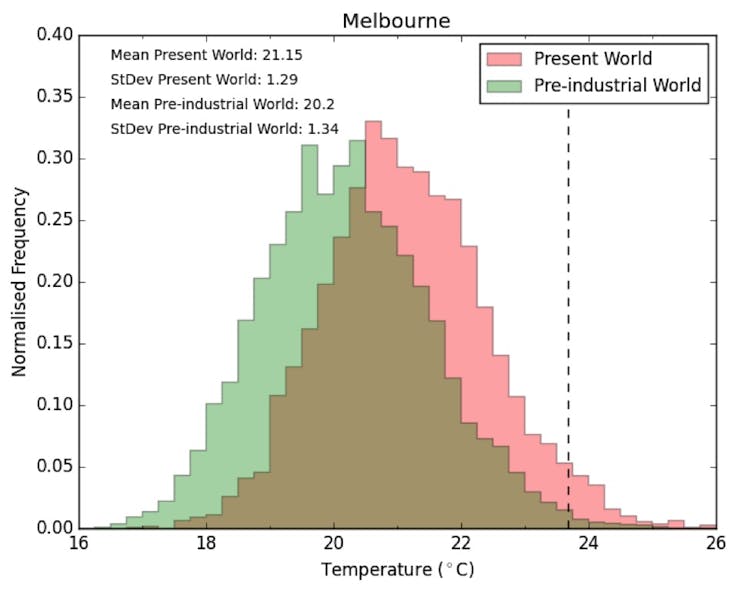This has been Australia’s hottest October on record. Barring an (extremely unlikely) cold snap, it will also be the hottest October for Victoria, and for Melbourne. And the record-breaking temperatures are at least six times more likely thanks to human-induced global warming.
But hold up, you say, October isn’t over yet! That’s true, but going by the current forecast from the Bureau of Meteorology we can see that new record high October average maximum temperatures are virtually certain.
In fact, the maximum temperature on Saturday would need to be below freezing across Victoria for the record not to be set, and there is no physically plausible scenario that could lead to that happening. Maybe if an asteroid landed in Victoria on Saturday (Halloween) and threw up enough dust to block out the sun? But that is very, very unlikely!
What’s driving the heat?
A record hot spell affected southeast Australia in the first week of October and a second exceptional hot spell followed two weeks later.

New record highs have been set for monthly and seasonal average temperatures across Australia at 12 times the rate of new record lows. Global warming is the cause.
To understand the role of human-caused global warming in the new records we compare simulations of the Earth’s climate from nine different models from around the world.
We only select climate models that do a good job of simulating the natural year-to-year variability of Australian temperatures. We then compare simulations for the current climate (with human influence) and for the climate without human influence. This approach has been used already to show the important role of global warming in record high Australian temperatures in 2013.
Using this method we can figure out the chances of breaking a record even before it happens. The previous hottest October in Australia was in 2014 with a temperature of 32.9°C. Our analysis shows an increase by at least a factor of six in the chances of setting the new October record maximum temperature for Australia due to global warming.
What about El Niño?
But we also have to factor in El Niño. As noted by the Bureau of Meteorology, such hot and dry spells are typical for the strong El Niño that is currently occurring in the Pacific Ocean.
To do this we use a huge set of data from a citizen science project called Weather@home ANZ. Weather@home allows you to donate your computer’s processing power to simulate Australia’s climate with and without human-caused climate change, and including El Niño.
This modelling approach, undertaken in partnership with the University of Oxford, has been used to assess the role of climate change in extreme weather and climate events in Australia in 2013 and 2014 and for typical El Niño conditions, such as this October.
We have more than 4,000 independent simulations of Australian weather and climate in October under El Niño conditions in the present world, and more than 8,000 simulations for El Niño conditions in a pre-industrial world with no human influences on climate.
These simulations allow us to assess the chances of breaking the existing records for October mean maximum temperature for the whole of Australia, for Victoria and for Melbourne under the current El Niño conditions.
For example, the figure below shows the simulated frequency of different October mean maximum temperatures for Melbourne with and without global warming.

The current record high mean maximum temperature of 23.7°C was set in October 1940. The chances of breaking the current record are much greater for the current climate, including the influence of global warming, than they would have been with no global warming.
In fact, human-caused climate change has very likely increased the chances of setting the new record for Melbourne by at least six times, even under El Niño conditions.
For the whole state of Victoria, global warming has increased the chances of breaking the existing record by at least six times, while for Australia under El Niño conditions, global warming has increased the chances by at least ten times. This is more than the increase found using the other climate models mentioned above, because now we have also taken into account the influence of El Niño.
Climate change due to human activity has dramatically increased the chances of setting new record temperatures in Melbourne, Victoria and Australia in October this year.
Of course, we have to wait another couple of days to see if our predictions hold true. But we are pretty confident they will.

